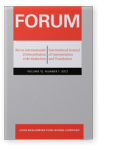Vol. 15:1 (2017) ► pp.142–156
Linguistic evaluation of translation errors in Chinese–English machine translations of patent titles
The title of an invention allows the reader to understand the significance of a patent claim, and the wording of the title recurs throughout the subsequent patent documentation. If the translation of the title is erroneous, the quality of the translation in other parts of the patent documentation also suffers. This research involved using linguistic evaluation to identify common translation errors in Chinese–English machine translations of patent titles and examine the quality of machine-translated patent titles. Special focus was placed on orthographic, morphological, lexical, semantic, and syntactic errors found in patent titles. We sought to answer the following questions: (1) What are the trends in the application of machine translation in the Taiwan Intellectual Property Office (TIPO)? (2) How is the quality of machine translation controlled at TIPO? (3) What are common errors in machine-translated patent titles? Through analysis of our findings, it is possible to estimate the level of effort required from a posteditor following translation, and to suggest methods of improving machine translations of patent titles. This study also generates information applicable to the training of patent translators and posteditors.
Article outline
- 1.Introduction
- 2.Development of MT at TIPO
- 2.1Translation evaluation method at TIPO
- 2.2Using linguistic error classification to evaluate MT output
- 3.Research method and data collection
- 4.Analysing patent translation quality from patent title translation errors
- 4.1Orthographic errors
- 4.2Morphological errors
- 4.3Lexical errors
- 4.4Semantic errors
- 4.5Syntactic errors
- 5.Conclusion
- Acknowledgements
-
References
This article is currently available as a sample article.
References
Cited by
Cited by 1 other publications
This list is based on CrossRef data as of 4 july 2024. Please note that it may not be complete. Sources presented here have been supplied by the respective publishers. Any errors therein should be reported to them.
